Analysis of UML and Project Management Methodology for System Design
VerifiedAdded on 2023/05/30
|8
|1709
|434
Report
AI Summary
This report delves into the relationship between the Unified Modeling Language (UML) and project management methodologies, specifically examining their independence. It highlights how UML, used for system design and software development, functions independently of the project life cycle stages within project management. The report discusses the functionalities of UML, including class relationships and system blueprints, contrasting them with the broader scope of project management, which encompasses stakeholder engagement and risk management. It emphasizes that while UML is a crucial part of the design phase in the project life cycle, the project management methodology provides the framework for the entire project, including technical and non-technical aspects. The report concludes by asserting that the notation provided by UML is independent of the project life cycle and project methodology, due to the differing nature of their functionalities. The report uses references to support the analysis.
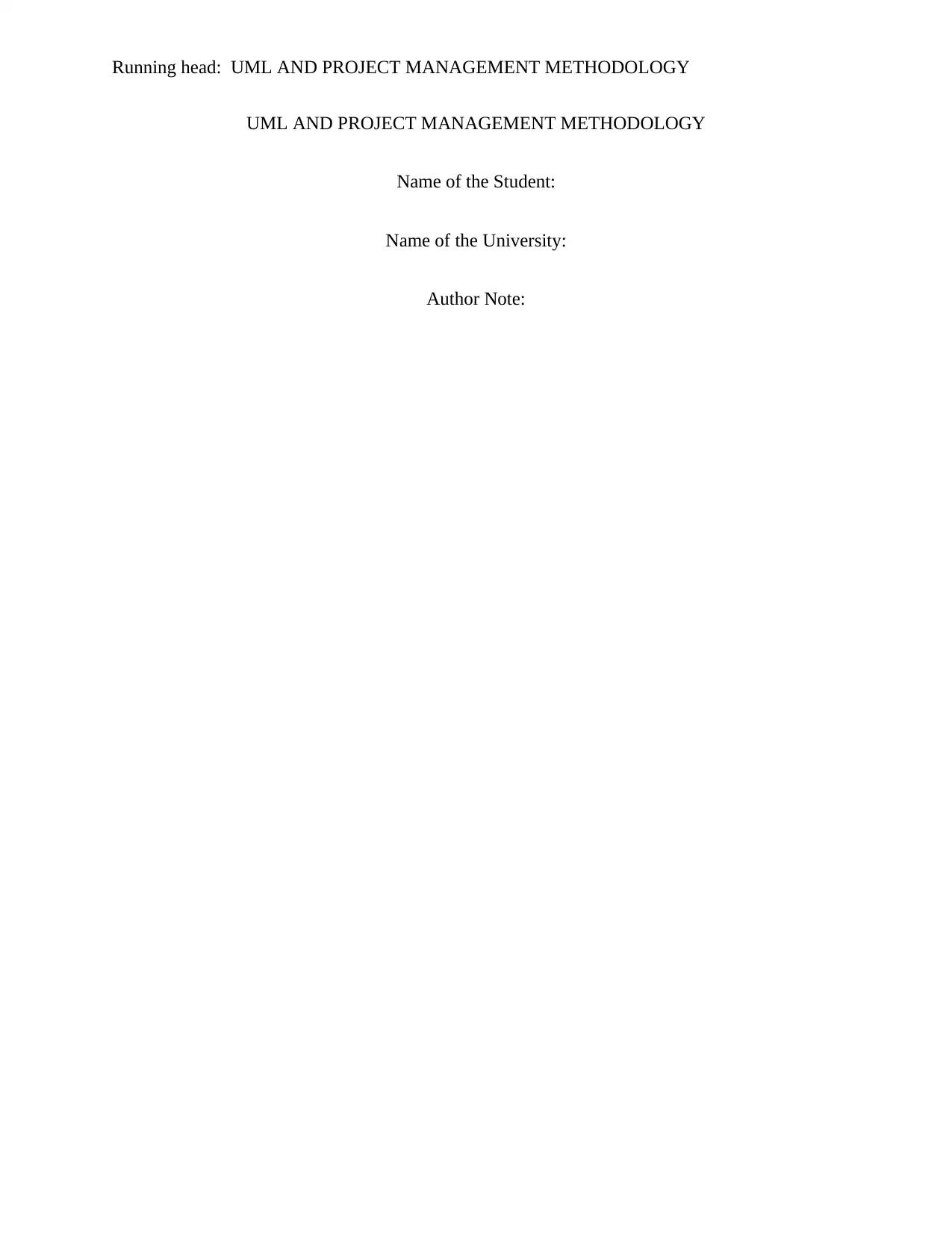
Running head: UML AND PROJECT MANAGEMENT METHODOLOGY
UML AND PROJECT MANAGEMENT METHODOLOGY
Name of the Student:
Name of the University:
Author Note:
UML AND PROJECT MANAGEMENT METHODOLOGY
Name of the Student:
Name of the University:
Author Note:
Paraphrase This Document
Need a fresh take? Get an instant paraphrase of this document with our AI Paraphraser
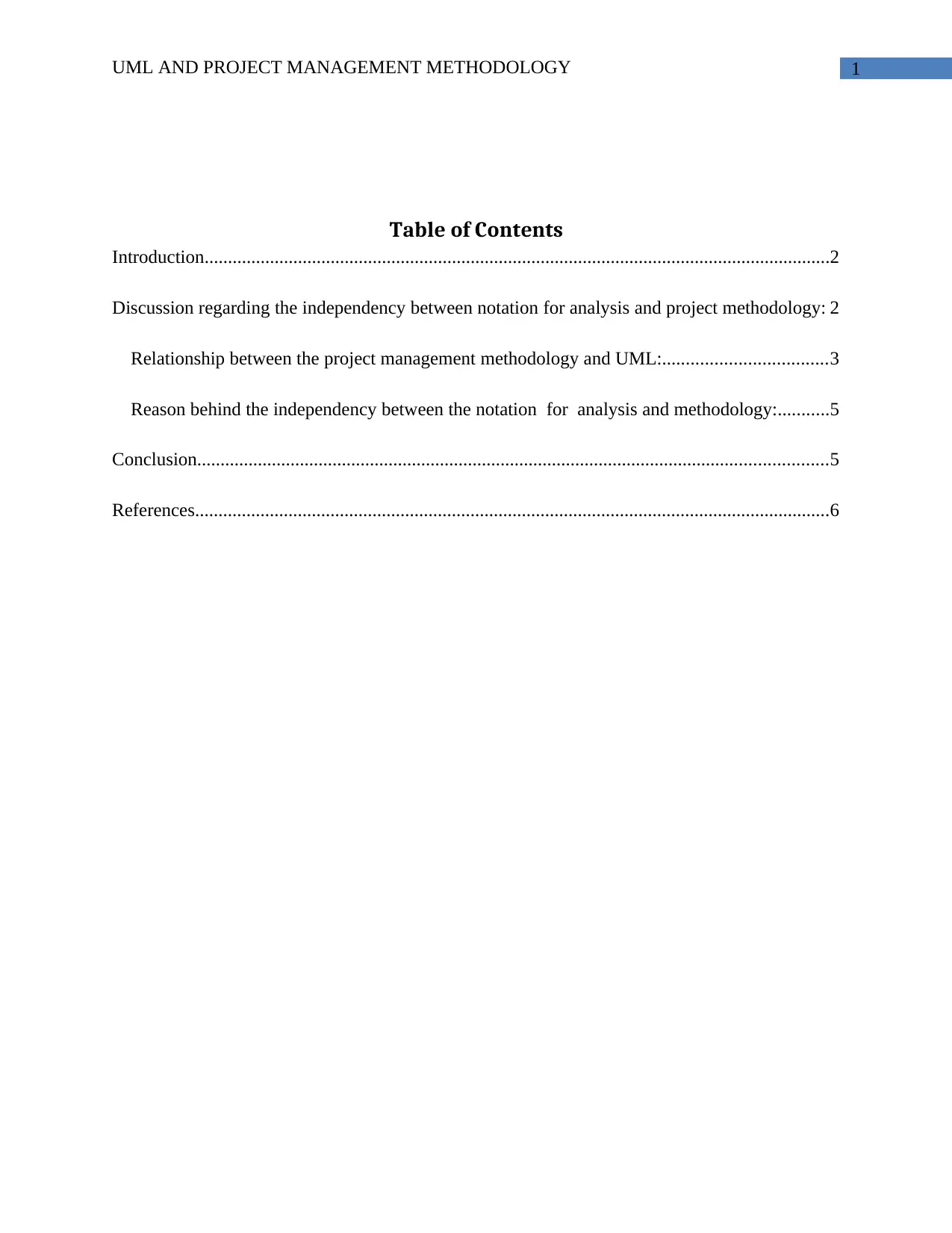
1UML AND PROJECT MANAGEMENT METHODOLOGY
Table of Contents
Introduction......................................................................................................................................2
Discussion regarding the independency between notation for analysis and project methodology: 2
Relationship between the project management methodology and UML:...................................3
Reason behind the independency between the notation for analysis and methodology:...........5
Conclusion.......................................................................................................................................5
References........................................................................................................................................6
Table of Contents
Introduction......................................................................................................................................2
Discussion regarding the independency between notation for analysis and project methodology: 2
Relationship between the project management methodology and UML:...................................3
Reason behind the independency between the notation for analysis and methodology:...........5
Conclusion.......................................................................................................................................5
References........................................................................................................................................6

2UML AND PROJECT MANAGEMENT METHODOLOGY
Introduction
UML is a framework that provides the relationship between the classes and its attributes
in the system. In the project management methodology the implementation of the project life
cycle for the compilation of the project is important (Cabot, Clarisó and Riera 2014). In this case,
the components of the UML diagram does not map into the stages of the project life cycle. It can
be said that the notation of UML is independent of the stages of the project life cycle (Soares
2017). On the other hand project life cycle is included in the project management methodology
which is concerned about the developing of project in a proper way .The project life cycle help to
meet all the desired requirements. The main objective of this paper is to evaluate the significance
of the independence between the notation of UML and the project management methodology
(Steenkamp and Bekker 2018). In order to discuss these different aspects of the project
management methodology and UML has been analyzed on the basis of the development of the
project.
Discussion regarding the independency between notation for analysis and project
methodology:
In order to design the software, identification of the functioning classes is important
along with defining the relationship between those classes. In the software development
scenario, the designing phase of the system or the software is done at the planning or designing
phase in the project life cycle (Dennis, Wixom and Tegarden 2015). The main concern of the
project methodology is that there is no guidance or sequening part provided by UML in the
Introduction
UML is a framework that provides the relationship between the classes and its attributes
in the system. In the project management methodology the implementation of the project life
cycle for the compilation of the project is important (Cabot, Clarisó and Riera 2014). In this case,
the components of the UML diagram does not map into the stages of the project life cycle. It can
be said that the notation of UML is independent of the stages of the project life cycle (Soares
2017). On the other hand project life cycle is included in the project management methodology
which is concerned about the developing of project in a proper way .The project life cycle help to
meet all the desired requirements. The main objective of this paper is to evaluate the significance
of the independence between the notation of UML and the project management methodology
(Steenkamp and Bekker 2018). In order to discuss these different aspects of the project
management methodology and UML has been analyzed on the basis of the development of the
project.
Discussion regarding the independency between notation for analysis and project
methodology:
In order to design the software, identification of the functioning classes is important
along with defining the relationship between those classes. In the software development
scenario, the designing phase of the system or the software is done at the planning or designing
phase in the project life cycle (Dennis, Wixom and Tegarden 2015). The main concern of the
project methodology is that there is no guidance or sequening part provided by UML in the
⊘ This is a preview!⊘
Do you want full access?
Subscribe today to unlock all pages.

Trusted by 1+ million students worldwide
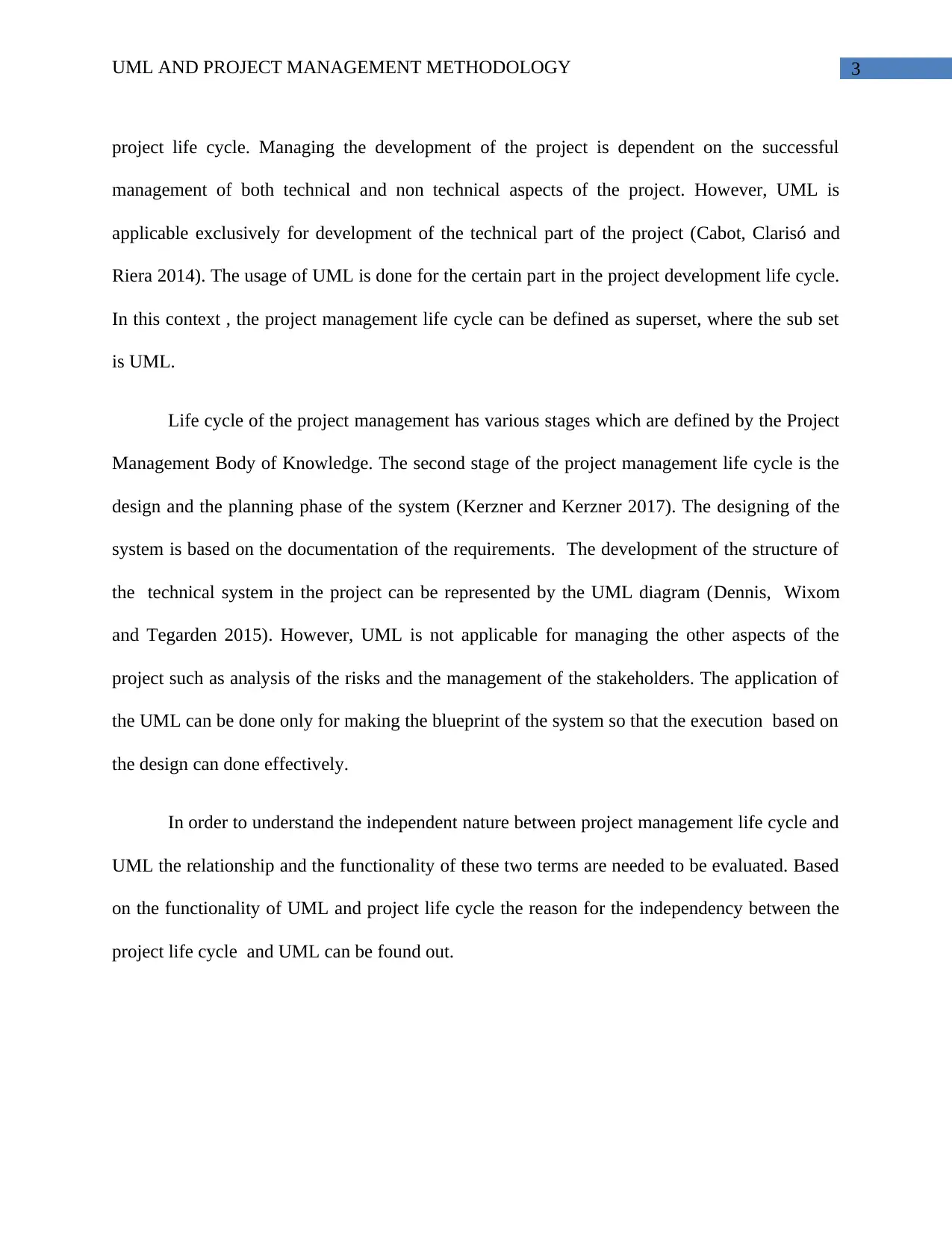
3UML AND PROJECT MANAGEMENT METHODOLOGY
project life cycle. Managing the development of the project is dependent on the successful
management of both technical and non technical aspects of the project. However, UML is
applicable exclusively for development of the technical part of the project (Cabot, Clarisó and
Riera 2014). The usage of UML is done for the certain part in the project development life cycle.
In this context , the project management life cycle can be defined as superset, where the sub set
is UML.
Life cycle of the project management has various stages which are defined by the Project
Management Body of Knowledge. The second stage of the project management life cycle is the
design and the planning phase of the system (Kerzner and Kerzner 2017). The designing of the
system is based on the documentation of the requirements. The development of the structure of
the technical system in the project can be represented by the UML diagram (Dennis, Wixom
and Tegarden 2015). However, UML is not applicable for managing the other aspects of the
project such as analysis of the risks and the management of the stakeholders. The application of
the UML can be done only for making the blueprint of the system so that the execution based on
the design can done effectively.
In order to understand the independent nature between project management life cycle and
UML the relationship and the functionality of these two terms are needed to be evaluated. Based
on the functionality of UML and project life cycle the reason for the independency between the
project life cycle and UML can be found out.
project life cycle. Managing the development of the project is dependent on the successful
management of both technical and non technical aspects of the project. However, UML is
applicable exclusively for development of the technical part of the project (Cabot, Clarisó and
Riera 2014). The usage of UML is done for the certain part in the project development life cycle.
In this context , the project management life cycle can be defined as superset, where the sub set
is UML.
Life cycle of the project management has various stages which are defined by the Project
Management Body of Knowledge. The second stage of the project management life cycle is the
design and the planning phase of the system (Kerzner and Kerzner 2017). The designing of the
system is based on the documentation of the requirements. The development of the structure of
the technical system in the project can be represented by the UML diagram (Dennis, Wixom
and Tegarden 2015). However, UML is not applicable for managing the other aspects of the
project such as analysis of the risks and the management of the stakeholders. The application of
the UML can be done only for making the blueprint of the system so that the execution based on
the design can done effectively.
In order to understand the independent nature between project management life cycle and
UML the relationship and the functionality of these two terms are needed to be evaluated. Based
on the functionality of UML and project life cycle the reason for the independency between the
project life cycle and UML can be found out.
Paraphrase This Document
Need a fresh take? Get an instant paraphrase of this document with our AI Paraphraser
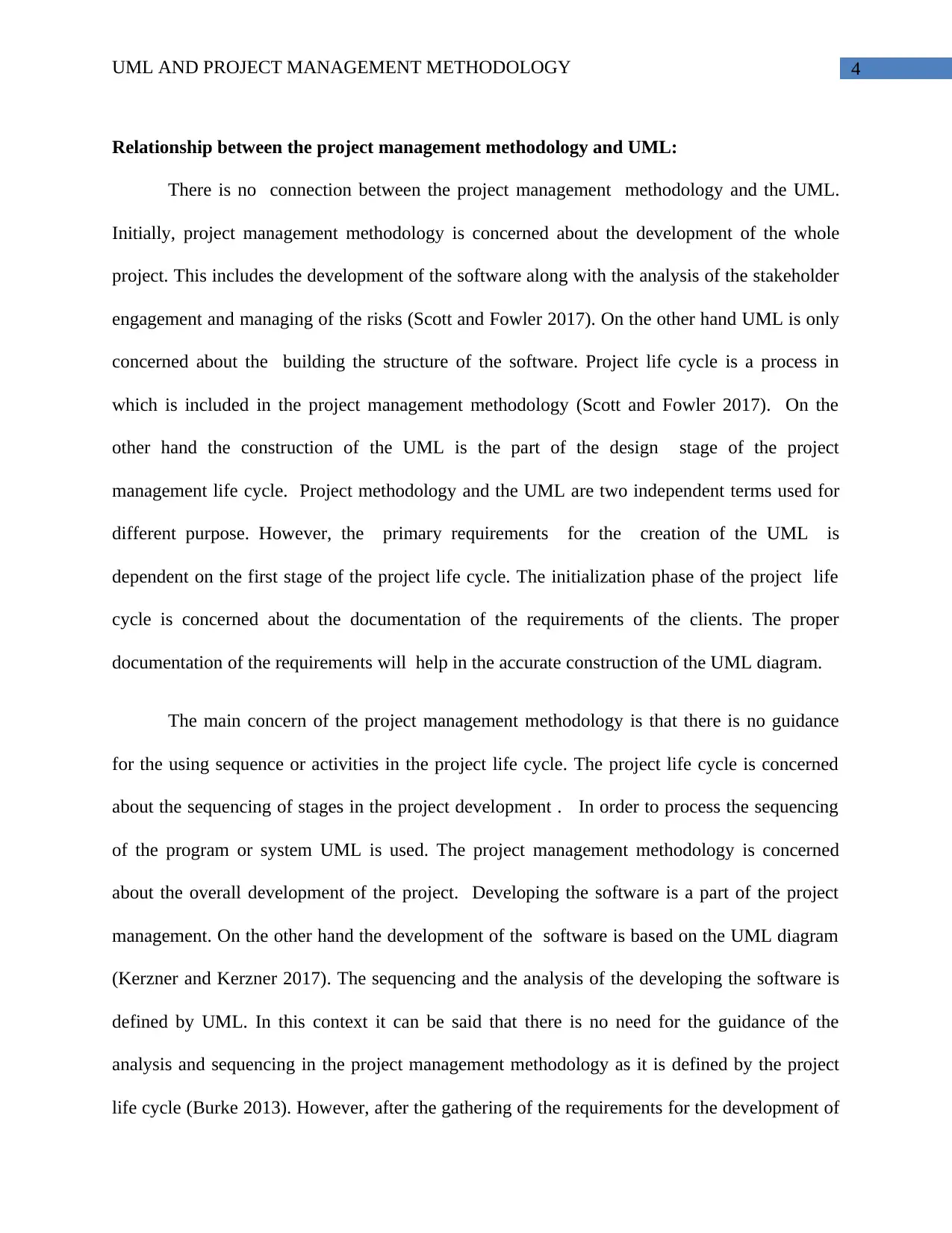
4UML AND PROJECT MANAGEMENT METHODOLOGY
Relationship between the project management methodology and UML:
There is no connection between the project management methodology and the UML.
Initially, project management methodology is concerned about the development of the whole
project. This includes the development of the software along with the analysis of the stakeholder
engagement and managing of the risks (Scott and Fowler 2017). On the other hand UML is only
concerned about the building the structure of the software. Project life cycle is a process in
which is included in the project management methodology (Scott and Fowler 2017). On the
other hand the construction of the UML is the part of the design stage of the project
management life cycle. Project methodology and the UML are two independent terms used for
different purpose. However, the primary requirements for the creation of the UML is
dependent on the first stage of the project life cycle. The initialization phase of the project life
cycle is concerned about the documentation of the requirements of the clients. The proper
documentation of the requirements will help in the accurate construction of the UML diagram.
The main concern of the project management methodology is that there is no guidance
for the using sequence or activities in the project life cycle. The project life cycle is concerned
about the sequencing of stages in the project development . In order to process the sequencing
of the program or system UML is used. The project management methodology is concerned
about the overall development of the project. Developing the software is a part of the project
management. On the other hand the development of the software is based on the UML diagram
(Kerzner and Kerzner 2017). The sequencing and the analysis of the developing the software is
defined by UML. In this context it can be said that there is no need for the guidance of the
analysis and sequencing in the project management methodology as it is defined by the project
life cycle (Burke 2013). However, after the gathering of the requirements for the development of
Relationship between the project management methodology and UML:
There is no connection between the project management methodology and the UML.
Initially, project management methodology is concerned about the development of the whole
project. This includes the development of the software along with the analysis of the stakeholder
engagement and managing of the risks (Scott and Fowler 2017). On the other hand UML is only
concerned about the building the structure of the software. Project life cycle is a process in
which is included in the project management methodology (Scott and Fowler 2017). On the
other hand the construction of the UML is the part of the design stage of the project
management life cycle. Project methodology and the UML are two independent terms used for
different purpose. However, the primary requirements for the creation of the UML is
dependent on the first stage of the project life cycle. The initialization phase of the project life
cycle is concerned about the documentation of the requirements of the clients. The proper
documentation of the requirements will help in the accurate construction of the UML diagram.
The main concern of the project management methodology is that there is no guidance
for the using sequence or activities in the project life cycle. The project life cycle is concerned
about the sequencing of stages in the project development . In order to process the sequencing
of the program or system UML is used. The project management methodology is concerned
about the overall development of the project. Developing the software is a part of the project
management. On the other hand the development of the software is based on the UML diagram
(Kerzner and Kerzner 2017). The sequencing and the analysis of the developing the software is
defined by UML. In this context it can be said that there is no need for the guidance of the
analysis and sequencing in the project management methodology as it is defined by the project
life cycle (Burke 2013). However, after the gathering of the requirements for the development of
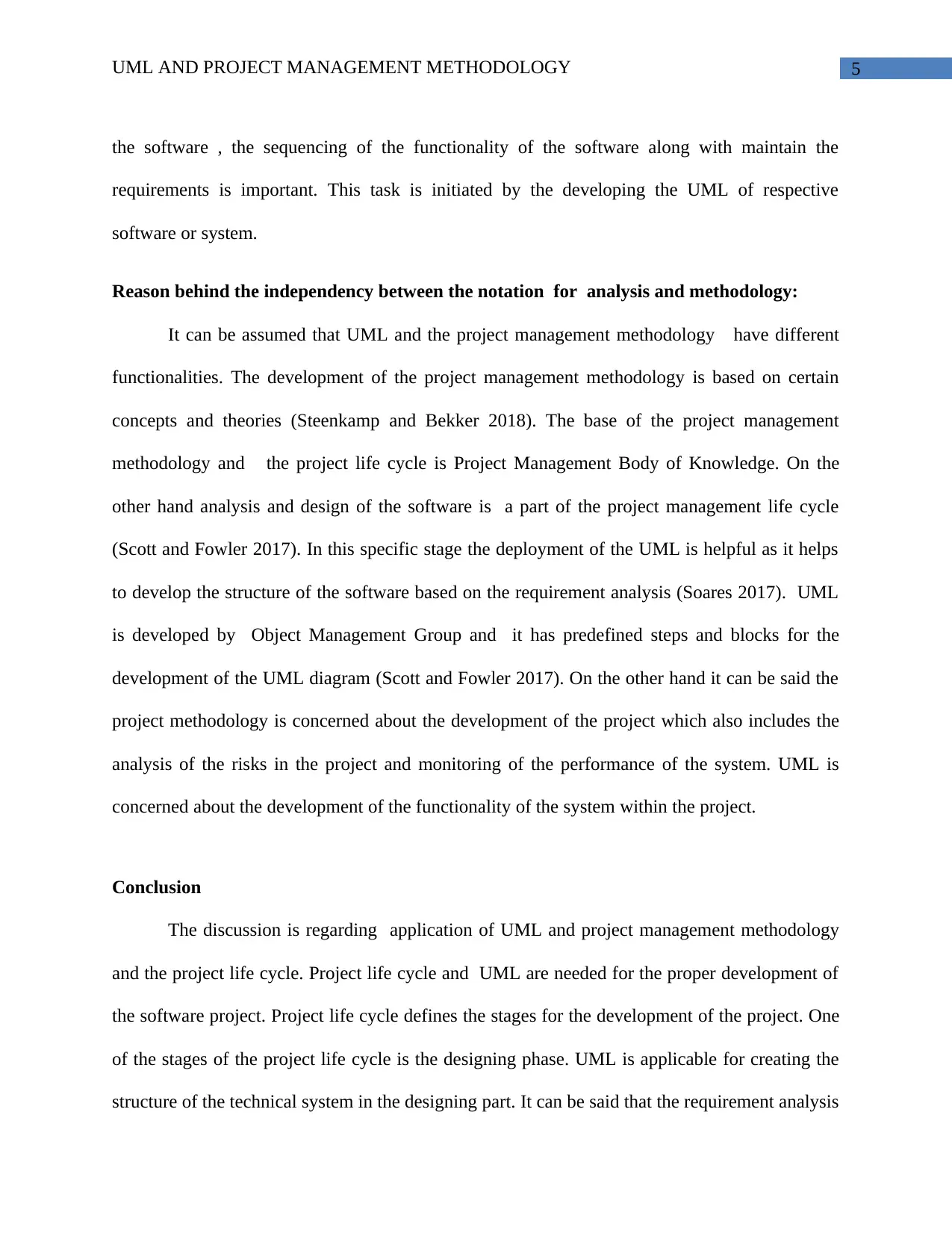
5UML AND PROJECT MANAGEMENT METHODOLOGY
the software , the sequencing of the functionality of the software along with maintain the
requirements is important. This task is initiated by the developing the UML of respective
software or system.
Reason behind the independency between the notation for analysis and methodology:
It can be assumed that UML and the project management methodology have different
functionalities. The development of the project management methodology is based on certain
concepts and theories (Steenkamp and Bekker 2018). The base of the project management
methodology and the project life cycle is Project Management Body of Knowledge. On the
other hand analysis and design of the software is a part of the project management life cycle
(Scott and Fowler 2017). In this specific stage the deployment of the UML is helpful as it helps
to develop the structure of the software based on the requirement analysis (Soares 2017). UML
is developed by Object Management Group and it has predefined steps and blocks for the
development of the UML diagram (Scott and Fowler 2017). On the other hand it can be said the
project methodology is concerned about the development of the project which also includes the
analysis of the risks in the project and monitoring of the performance of the system. UML is
concerned about the development of the functionality of the system within the project.
Conclusion
The discussion is regarding application of UML and project management methodology
and the project life cycle. Project life cycle and UML are needed for the proper development of
the software project. Project life cycle defines the stages for the development of the project. One
of the stages of the project life cycle is the designing phase. UML is applicable for creating the
structure of the technical system in the designing part. It can be said that the requirement analysis
the software , the sequencing of the functionality of the software along with maintain the
requirements is important. This task is initiated by the developing the UML of respective
software or system.
Reason behind the independency between the notation for analysis and methodology:
It can be assumed that UML and the project management methodology have different
functionalities. The development of the project management methodology is based on certain
concepts and theories (Steenkamp and Bekker 2018). The base of the project management
methodology and the project life cycle is Project Management Body of Knowledge. On the
other hand analysis and design of the software is a part of the project management life cycle
(Scott and Fowler 2017). In this specific stage the deployment of the UML is helpful as it helps
to develop the structure of the software based on the requirement analysis (Soares 2017). UML
is developed by Object Management Group and it has predefined steps and blocks for the
development of the UML diagram (Scott and Fowler 2017). On the other hand it can be said the
project methodology is concerned about the development of the project which also includes the
analysis of the risks in the project and monitoring of the performance of the system. UML is
concerned about the development of the functionality of the system within the project.
Conclusion
The discussion is regarding application of UML and project management methodology
and the project life cycle. Project life cycle and UML are needed for the proper development of
the software project. Project life cycle defines the stages for the development of the project. One
of the stages of the project life cycle is the designing phase. UML is applicable for creating the
structure of the technical system in the designing part. It can be said that the requirement analysis
⊘ This is a preview!⊘
Do you want full access?
Subscribe today to unlock all pages.

Trusted by 1+ million students worldwide
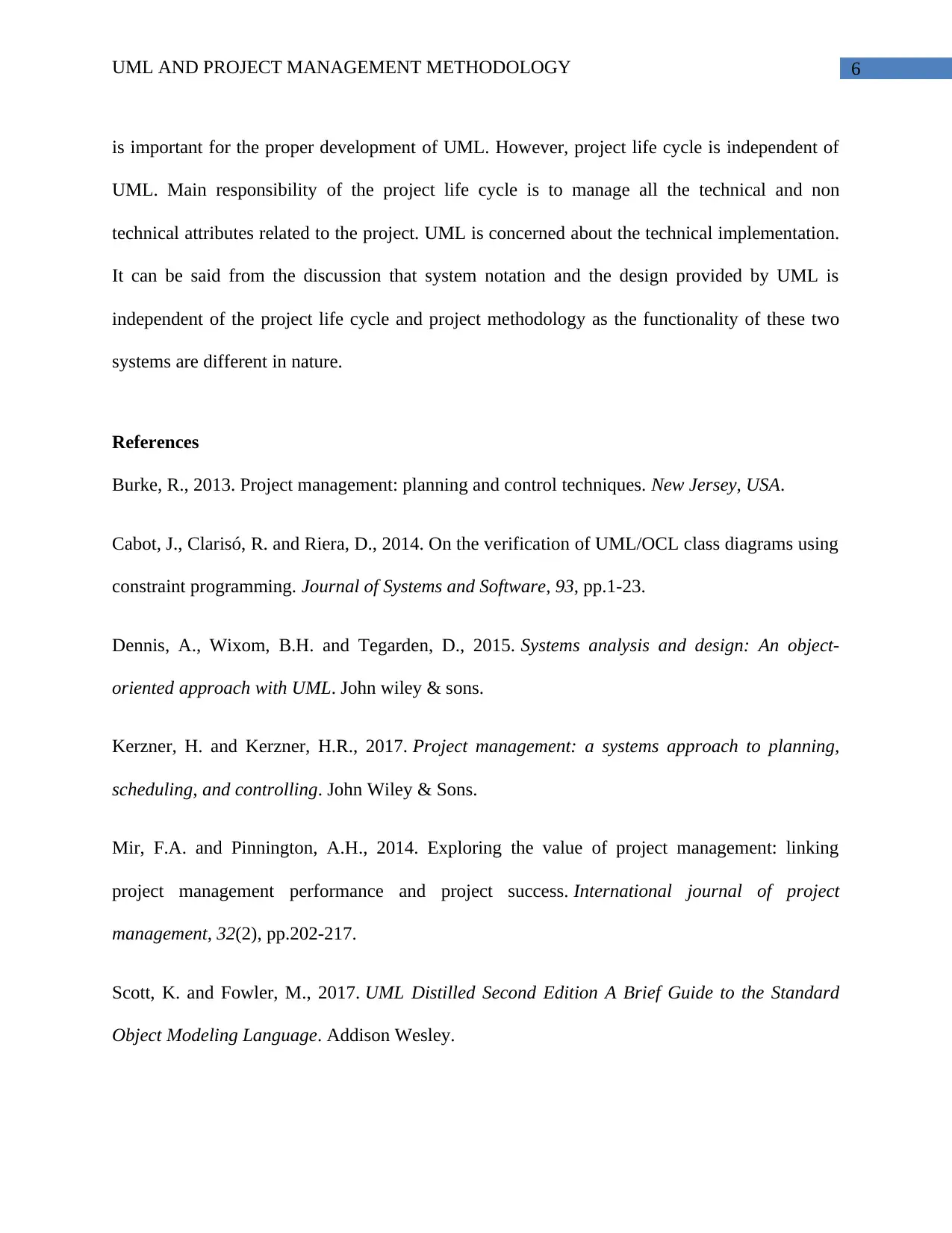
6UML AND PROJECT MANAGEMENT METHODOLOGY
is important for the proper development of UML. However, project life cycle is independent of
UML. Main responsibility of the project life cycle is to manage all the technical and non
technical attributes related to the project. UML is concerned about the technical implementation.
It can be said from the discussion that system notation and the design provided by UML is
independent of the project life cycle and project methodology as the functionality of these two
systems are different in nature.
References
Burke, R., 2013. Project management: planning and control techniques. New Jersey, USA.
Cabot, J., Clarisó, R. and Riera, D., 2014. On the verification of UML/OCL class diagrams using
constraint programming. Journal of Systems and Software, 93, pp.1-23.
Dennis, A., Wixom, B.H. and Tegarden, D., 2015. Systems analysis and design: An object-
oriented approach with UML. John wiley & sons.
Kerzner, H. and Kerzner, H.R., 2017. Project management: a systems approach to planning,
scheduling, and controlling. John Wiley & Sons.
Mir, F.A. and Pinnington, A.H., 2014. Exploring the value of project management: linking
project management performance and project success. International journal of project
management, 32(2), pp.202-217.
Scott, K. and Fowler, M., 2017. UML Distilled Second Edition A Brief Guide to the Standard
Object Modeling Language. Addison Wesley.
is important for the proper development of UML. However, project life cycle is independent of
UML. Main responsibility of the project life cycle is to manage all the technical and non
technical attributes related to the project. UML is concerned about the technical implementation.
It can be said from the discussion that system notation and the design provided by UML is
independent of the project life cycle and project methodology as the functionality of these two
systems are different in nature.
References
Burke, R., 2013. Project management: planning and control techniques. New Jersey, USA.
Cabot, J., Clarisó, R. and Riera, D., 2014. On the verification of UML/OCL class diagrams using
constraint programming. Journal of Systems and Software, 93, pp.1-23.
Dennis, A., Wixom, B.H. and Tegarden, D., 2015. Systems analysis and design: An object-
oriented approach with UML. John wiley & sons.
Kerzner, H. and Kerzner, H.R., 2017. Project management: a systems approach to planning,
scheduling, and controlling. John Wiley & Sons.
Mir, F.A. and Pinnington, A.H., 2014. Exploring the value of project management: linking
project management performance and project success. International journal of project
management, 32(2), pp.202-217.
Scott, K. and Fowler, M., 2017. UML Distilled Second Edition A Brief Guide to the Standard
Object Modeling Language. Addison Wesley.
Paraphrase This Document
Need a fresh take? Get an instant paraphrase of this document with our AI Paraphraser
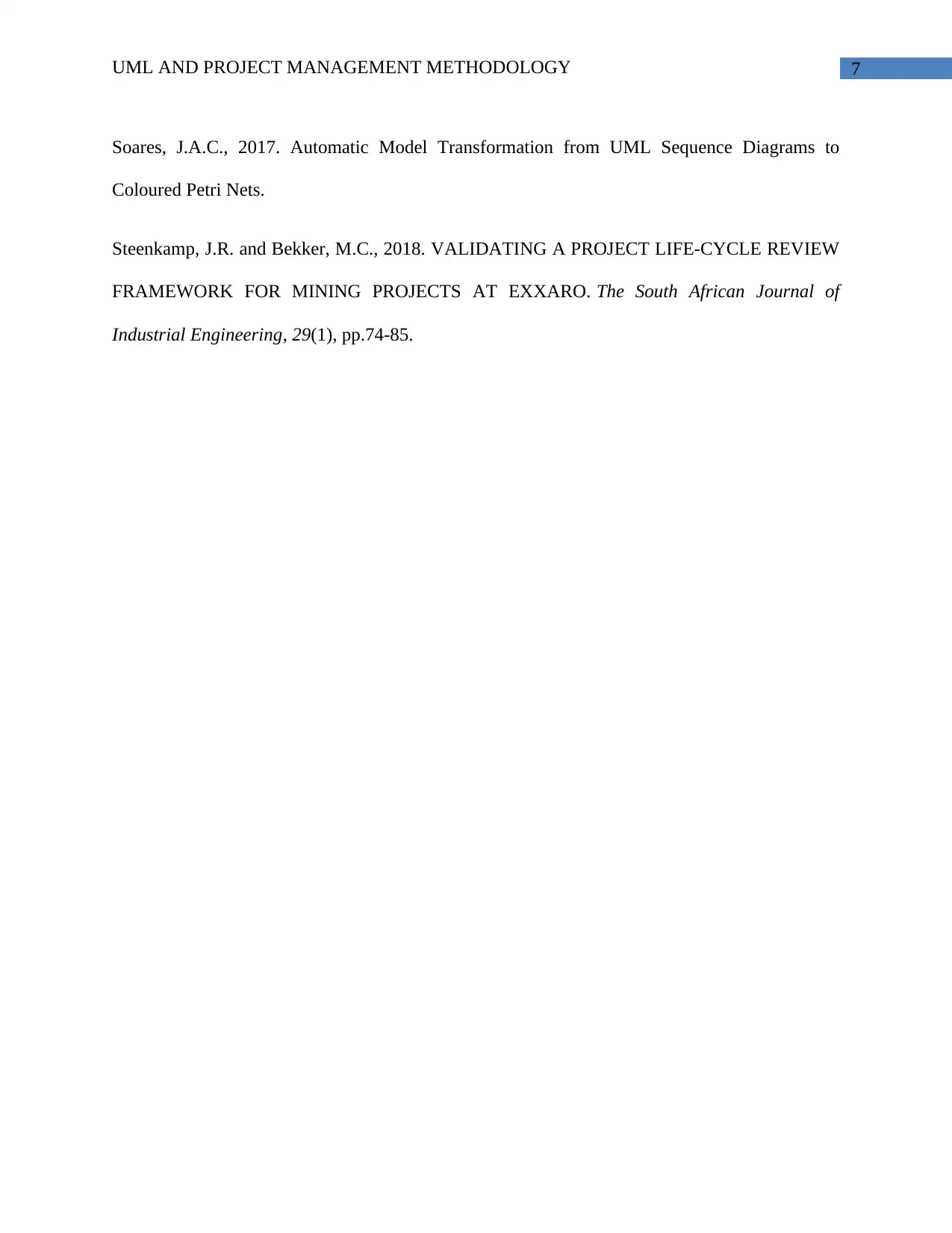
7UML AND PROJECT MANAGEMENT METHODOLOGY
Soares, J.A.C., 2017. Automatic Model Transformation from UML Sequence Diagrams to
Coloured Petri Nets.
Steenkamp, J.R. and Bekker, M.C., 2018. VALIDATING A PROJECT LIFE-CYCLE REVIEW
FRAMEWORK FOR MINING PROJECTS AT EXXARO. The South African Journal of
Industrial Engineering, 29(1), pp.74-85.
Soares, J.A.C., 2017. Automatic Model Transformation from UML Sequence Diagrams to
Coloured Petri Nets.
Steenkamp, J.R. and Bekker, M.C., 2018. VALIDATING A PROJECT LIFE-CYCLE REVIEW
FRAMEWORK FOR MINING PROJECTS AT EXXARO. The South African Journal of
Industrial Engineering, 29(1), pp.74-85.
1 out of 8
Related Documents
Your All-in-One AI-Powered Toolkit for Academic Success.
+13062052269
info@desklib.com
Available 24*7 on WhatsApp / Email
![[object Object]](/_next/static/media/star-bottom.7253800d.svg)
Unlock your academic potential
Copyright © 2020–2025 A2Z Services. All Rights Reserved. Developed and managed by ZUCOL.





